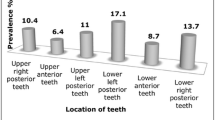Abstract
Background
Tooth wear and acid erosion have not been previously investigated in Jordanian schoolchildren.
Aim
To determine the prevalence of tooth wear and associations for a range of dietary and behavioural risk factors.
Methods
A sample of 1,602 children aged between 15 and 16 years were randomly selected from 32 schools in Amman, Jordan. Tooth wear was measured using the modified Tooth Wear Index and dichotomised on the presence or absence of exposed dentine. Analysis of questionnaire items was performed by multiple logistic regression analysis.
Results
Dentine was exposed in 51 % of children, and males (59 %) had significantly more tooth wear than females (42 %), OR = 1.9, 95 % CI 1.6, 2.4, p < 0.0001. Over 40 % of children had dentine exposed occlusally, mainly the lower first molars, and less than 1 % of the children had dentine exposed palatally. Daily consumption of oranges, ketchup, olives and sweetened coffee was associated with tooth wear through enamel to expose dentine. Carbonated drinks (fizzy) were on the borderline of significance at p = 0.055. The mean DMFT (5.52) was significantly greater in children without tooth wear compared to children with tooth wear (4.13) (p < 0.001). DMFT, gender, daily consumption of oranges and daily consumption of ketchup were significantly associated with tooth wear in the multiple regression model.
Conclusion
In this sample of children resident in Amman, Jordan, males had significantly more tooth wear than females. The acidic dietary items associated with tooth wear and, thus, dental erosion included oranges, olives and tomato ketchup.


Similar content being viewed by others
References
Al-Dlaigan YH, Shaw L, Smith A. Dental erosion in a group of British 14-year-old, school children. Part I: prevalence and influence of differing socioeconomic backgrounds. Br Dent J. 2001;190:145–9.
Al-Hiyasat AS, Khasawneh SF, Khader YS. Tooth wear among psychiatric patients: prevalence, distribution, and associated factors. Int J Prosthod. 2006;19:403–9.
Al-Majed I, Maguire A, Murray JJ. Risk factors for dental erosion in 5–6 year old and 12–14 year old boys in Saudi Arabia. Community Dent Oral Epidemiol. 2002;30:38–46.
Amin WM, Al-Omoush SA, Hattab FN. Oral health status of workers exposed to acid fumes in phosphate and battery industries in Jordan. Int Dent J. 2001;51:169–74.
Bardolia P, Burnside G, Ashcroft A, et al. Prevalence and risk indicators of erosion in thirteen- to fourteen-year-olds on the Isle of Man. Caries Res. 2010;44:165–8.
Bardsley PF, Taylor S, Milosevic A. Epidemiological studies of tooth wear and dental erosion in 14-year-old children in North West England. Part 1: the relationship with water fluoridation and social deprivation. Br Dent J. 2004;197:413–6.
Bartlett DW, Coward PY, Nikkah C, Wilson RF. The prevalence of tooth wear in a cluster sample of adolescent schoolchildren and its relationship with potential explanatory factors. Br Dent J. 1998;184:125–9.
Chadwick BL, White DA, Morris AJ, Evans D, Pitts NB. Non-carious conditions in children in the UK, 2003. Br Dent J. 2006;200:379–84.
Deery C, Wagner ML, Longbottom C, Simon R, Nugent ZJ. The prevalence of dental erosion in a United States and a United Kingdom sample of adolescents. Pediatr Dent. 2000;22:505–10.
Dugmore CR, Rock WP. The prevalence of tooth erosion in 12-year-old children. Br Dent J. 2004a;196:279–82.
Dugmore CR, Rock WP. A multifactorial analysis of factors associated with dental erosion. Br Dent J. 2004b;196:283–6.
Ganss C, Klimek J, Lussi A. Accuracy and consistency of the visual diagnosis of exposed dentine on worn occlusal/incisal surfaces. Caries Res. 2006;40:208–12.
Gregg T, Mace S, West NX, Addy M. A study in vitro of the abrasive effect of the tongue on enamel and dentine by acid erosion. Caries Res. 2004;38:557–60.
Gurgel CV, Rios D, Buzalaf MAR, et al. Dental erosion in a group of 12- and 16-year-old Brazilian schoolchildren. Pediatr Dent. 2011;33:23–8.
Harding MA, Whelton HP, Shirodaria SC, O’Mullane DM, Cronin MS. Is tooth wear in the primary dentition predictive of tooth wear in the permanent dentition? Report from a longitudinal study. Community Dent Health. 2010;27:41–5.
Milosevic A, Young PJ, Lennon MA. The prevalence of tooth wear in 14-year-old school children in Liverpool. Community Dent Health. 1994;11:83–6.
Milosevic A, Lennon MA, Fear SC. Risk factors associated with tooth wear in teenagers: a case control study. Community Dent Health. 1997;14:143–7.
Milosevic A. The problem with an epidemiological index for dental erosion. Brit Dent J. 2011;211:201–3.
O’Brien M. Children’s Dental Health in the United Kingdom 1993. Office of Population Censuses and Surveys. London: HMSO; 1994.
O’Sullivan E, Milosevic A. British Society of Paediatric Dentistry. UK National Clinical Guidelines in Paediatric Dentistry: diagnosis, prevention and management of dental erosion. Int J Paediatr Dent. 2008;18(Suppl 1):29–38.
Pitts NB, Evans DJ, Pine CM. British Association for the Study of Community Dentistry (BASCD) diagnostic criteria for caries prevalence surveys-1996/97. Community Dent Health. 1997;14(Suppl 1):6–9.
Sanhouri NM, Ziada HM, Ahmed GI, Kamis AH. Tooth surface loss, prevalence and associated risk factors among 12–14 years school children in Khartoum State, Sudan. Community Dent Health. 2010;27:206–12.
The Population and Housing Census. Department of Statistics. Jordan: Amman; 2004.
van Rijkom HM, Truin GJ, Frencken JEFM, et al. Prevalence, distribution and background variables of smooth-bordered tooth wear in teenagers in The Hague, The Netherlands. Caries Res. 2002;36:147–54.
Young A, Amaechi BT, Dugmore C, et al. Current erosion indices–flawed or valid? Summary. Clin Oral Investig. 2008;12(Suppl 1):S59–63.
Acknowledgments
The authors wish to thank all the school authorities for their enthusiasm and willingness to facilitate this study. Especial thanks must go to the children themselves. This study would not have been possible without the financial support from The British Council and The Deanship of Academic Research at The University of Jordan.
Author information
Authors and Affiliations
Corresponding author
Rights and permissions
About this article
Cite this article
Abu-Ghazaleh, S.B., Burnside, G. & Milosevic, A. The prevalence and associated risk factors for tooth wear and dental erosion in 15- to 16-year-old schoolchildren in Amman, Jordan. Eur Arch Paediatr Dent 14, 21–27 (2013). https://doi.org/10.1007/s40368-012-0006-3
Received:
Accepted:
Published:
Issue Date:
DOI: https://doi.org/10.1007/s40368-012-0006-3




